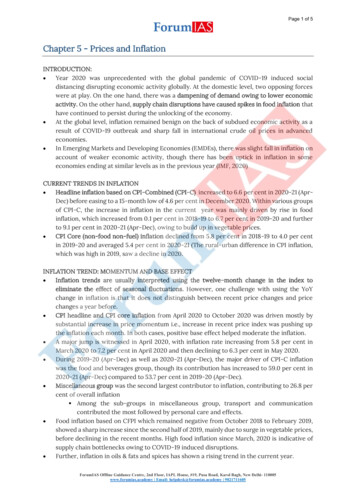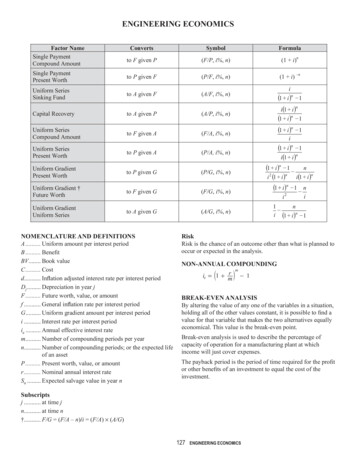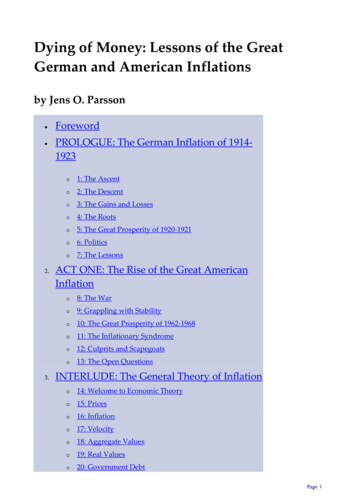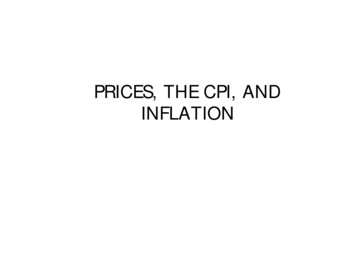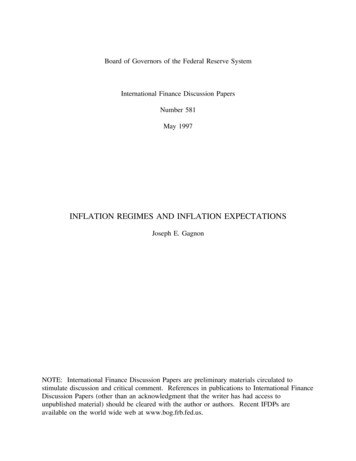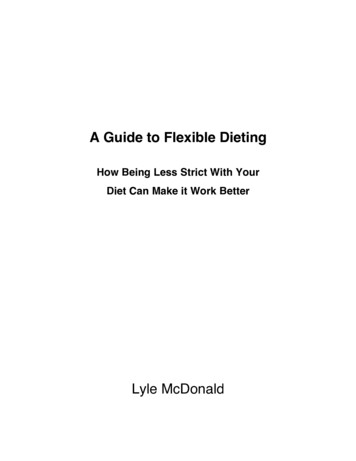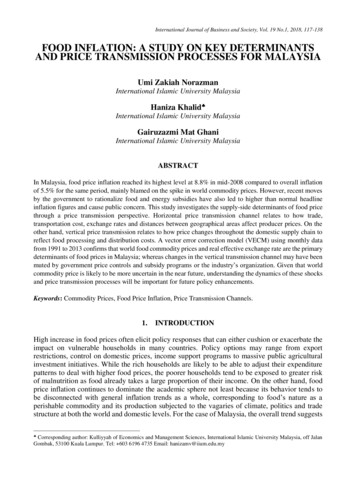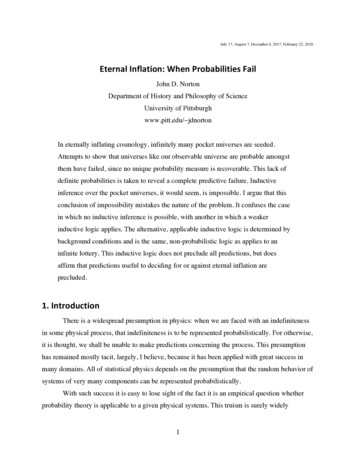
Transcription
July 17, August 7, December 8, 2017. February 22, 2018.Eternal Inflation: When Probabilities FailJohn D. NortonDepartment of History and Philosophy of ScienceUniversity of Pittsburghwww.pitt.edu/ jdnortonIn eternally inflating cosmology, infinitely many pocket universes are seeded.Attempts to show that universes like our observable universe are probable amongstthem have failed, since no unique probability measure is recoverable. This lack ofdefinite probabilities is taken to reveal a complete predictive failure. Inductiveinference over the pocket universes, it would seem, is impossible. I argue that thisconclusion of impossibility mistakes the nature of the problem. It confuses the casein which no inductive inference is possible, with another in which a weakerinductive logic applies. The alternative, applicable inductive logic is determined bybackground conditions and is the same, non-probabilistic logic as applies to aninfinite lottery. This inductive logic does not preclude all predictions, but doesaffirm that predictions useful to deciding for or against eternal inflation areprecluded.1. IntroductionThere is a widespread presumption in physics: when we are faced with an indefinitenessin some physical process, that indefiniteness is to be represented probabilistically. For otherwise,it is thought, we shall be unable to make predictions concerning the process. This presumptionhas remained mostly tacit, largely, I believe, because it has been applied with great success inmany domains. All of statistical physics depends on the presumption that the random behavior ofsystems of very many components can be represented probabilistically.With such success it is easy to lose sight of the fact it is an empirical question whetherprobability theory is applicable to a given physical systems. This truism is surely widely1
recognized, but almost never expressed. A rare exception is Marc Kac (1959, p. 5), who put itthis way:1To me there is no methodological distinction between the applicability ofdifferential equations to astronomy and of probability to thermodynamics orquantum mechanics.It works! And brutally pragmatic as this point of view is, no better substitute hasbeen found.And, we might add, as long as it works, we should continue using probability theory; and not asktoo many troublesome questions. When it fails, however, we need not collapse in despair. It istime to ask troublesome questions. If the applicability of probabilities is an empirical questiondetermined by the facts of the physical system, then is it not an empirical question whether someother formal representation will succeed where probabilities have failed?My purpose here is to review a case in which probabilities fail but another formalrepresentation of the indefiniteness succeeds. It arises in recent cosmology in the context of the“measure problem.” The version of the problem to be described here arises in so-called “eternalinflation.” According to this theory, the universe persists indefinitely in a state of very rapid,inflationary expansion, driven, in the simplest versions, by the exotic matter of a single inflatonfield. During the inflationary expansion, it spins off infinitely many pocket universes in whichthe exotic matter of the inflaton field reverts to ordinary matter. Some of these pocket universesmay well be like our observable universe. Others may be unlike our observable universe.The prospects of inflationary cosmology as a viable theory would be greatly advanced ifit could be established that pocket universes very much like ours are not just possible, but are tobe expected. Otherwise the existence of our observable universe would be merely a fortuitouscoincidence in the theory. The standard approach to demonstrating this expectation is to seek aprobability measure over the different properties observers will find in the pocket universes. Themeasure problem is that there is no natural measure recoverable. Many measures may beimposed on the pocket universes. All face difficulties. None has proven to be uniquely successful.1While I believe that Kac’s view is widely held, a quite extensive search in the literature hasfailed to find similar, clear statements of the empirical character of the applicability ofprobability theory to physical problems, beyond remarks by Bohm quoted in Section 5 below.2
To see the particular difficulty addressed in this paper, we simplify the problem bydividing the pocket universes into those like ours (“like”) and those unlike ours (“unlike”).Eternal inflation provides a countable infinity of each. Computing the ratio of probabilities oflike to unlike requires us to compute the ratio of an infinity to an infinity, without any of thenormal means of regularizing such a computation. Recognition of this difficulty has now dividedthose who work on inflationary cosmology into a majority that continues to search fruitlessly fora serviceable measure; and a minority that portrays the failure of the search for a measure as ablanket failure of the power of the theory of eternal inflation to make predictions.Where both sides agree, however, is on the tacit assumption that the indefiniteness of thepocket universes has to be represented probabilistically. It is, they agree, either that or the theoryhas failed. The proposal of this paper is that this assumption fails in this case and should bediscarded for eternal inflation. I will argue that we can still reason inductively about theprospects for universes like ours. However the natural inductive logic—the “infinite lottery”logic—is predictively weaker than a probabilistic logic and quite foreign to intuitions that havebeen tutored by schooling in probabilistic thinking. It is, however, the logic that the problemspecification delineates. To resist it makes about as much sense as resisting the logic ofprobabilistic inferences over coin tosses and die throws.My proposal is not that the predictive problems of eternal inflation are resolved byadopting this logic. They are not. The new logic affirms them. We must distinguish between thenarrower case in which the prospects for useful prediction are limited and the broader case inwhich no inductive logic is applicable at all. Here, an inductive logic is applicable, but one of itspositive consequences is that the prospects for useful prediction are limited.My principal point concerns inductive logic, not prediction. For too long, in both scienceand philosophy of science, too many of us have tacitly accepted a false dilemma: either anindefiniteness can be treated probabilistically or it cannot be treated at all. Eternal inflationprovides a clear example in present science in which there is a third option. A different, nonprobabilistic logic is applicable to its indefinitenesses.Section 2 below will review how the measure problem arises in eternal inflationarycosmology through the need to form ill-defined ratios of infinities. It has become standard in theinflationary cosmology literature to illustrate the problem with what I call the “countingargument.” It uses a simple reordering of a sequence of numbers and will be described in Section3
3. The following Section 4 will recount the widespread view amongst cosmologists that thefailure of probability theory in this case threatens to bring a complete failure of the overall theoryof eternal inflation, for, they fear, such a theory is deprived of its predictive powers. To helpsupport an alternative diagnosis, Section 5 will review claims that probabilistic representationrequires specific hospitable background conditions. Section 6 will invert those claims: if suchbackground conditions do not favor probabilistic representation, then, I will argue there, it is anempirical matter to determine which inductive logic is favored by them. Section 7 willreconfigure the counting argument to derive core behaviors of the applicable, non-probabilisticlogic. The next Section 8 recalls that the logic so identified is the same logic as governs drawingsfrom a fair, infinite lottery. While this logic is weaker predictively than a probabilistic logic,Section 9 reports inferences that can be made using it. The most important consequence foreternal inflation is a positive result that affirms its predictive woes: virtually all distributions oflike and unlike across a countable infinity of pocket universes are assigned equal chances. Hencethe logic cannot discriminate among them. Section 10 has conclusions. An appendix developsthe essential, pertinent content of the theory of eternally inflating cosmology.2. The Measure ProblemIn an eternally inflating cosmology, the bulk of the universe undergoes a never-ending,rapidly accelerating expansion that is unlike what we see in the observable portion of theuniverse. During this process, pocket universes are spun off continually by probabilisticprocesses described in the Appendix. These pocket universes are no longer inflating and may beor may not be like our observable universe. One of them, it is supposed, is our observableuniverse. These pocket universes, together with the inflating regions, form a multiverse. It wouldbe better for the empirical grounding of inflationary cosmology if pocket universes like ourobservable universes are to be expected. Otherwise the existence of our observable universewould merely be a fortuitous coincidence in a multiverse of pocket universes. A long-standinggoal of eternal inflation theorists has been to assess the probability of pocket universes like ourobservable universe and, it is hoped, to show them probable.4
In spite of two decades of attention, determining the appropriate probability measure hasproven very troublesome. It is now known as the “measure problem.” Vilenkin (2007, p. 6777;his emphasis) gives a typical definition:The key problem is then to calculate the probability distribution for the constants [inthe laws governing the pocket universes]. It is often referred to as the measureproblem.The probability Pj of observing vacuum j can be expressed as a productPj Pj(prior) fj,[(1)]where the prior probability Pj(prior) is determined by the geography of the landscapeand by the dynamics of eternal inflation, and the selection factor fj characterizes thechances for an observer to evolve in vacuum j. The distribution [(1)] gives theprobability for a randomly picked observer to be in a given vacuum.Note that the probability sought is the probability that an observer finds the designated vacuumstate, not merely that such a state arises.Many measures have been proposed. Winitski (2007, §5.3.2; 2009, §6.1) divides theminto two types. The “volume-based” measures are derived from the ensemble of all observers atall events in spacetime. The “world-line based” measures employ a smaller ensemble ofobservers in the vicinity of one cosmically co-moving worldline or even one arbitrarily chosentimelike geodesic.The difficulty is that none of these measures is unproblematic and no uniquely defined,natural measure has been found that solves the problem adequately. A volume measure mightneed to slice the spacetime into spacelike surfaces of simultaneous events. In the “gaugeproblem” (as described by Winitzki, 2007, p. 179; 2009, p. 88), there prove to be many ways toeffect this slicing without any being naturally preferred. However, the differences make adifference to the resulting measures. This is just the first of many problems.2 For example, ameasure can be recovered by considering a volume of spacetime that grows indefinitely towardsthe future. Since eternal inflation creates new pocket universes at an accelerating rate3 as the2For more details of the difficulties, see Smeenk (2014), which is a recent survey of the measureproblem in the philosophy of science literature.3When counted by the protocol Guth (2000, §7) describes.5
universe evolves, the sampling of this scheme is heavily weighted towards young, newly createdpocket universes. This creates what Guth (2000, §7) calls the “youngness problem”: an olderuniverse like our own is extremely unlikely, even in relation to one that is only slightly younger.The most enduring problem, however, is mentioned most frequently: the measurerequires taking the ratios of infinities; and these ratios are not well defined. Freivogel (2011, p.2)puts it most simply. If observation of A occurs NA times and observation of B occurs NB times,then the ratio of the probabilities of A to B ispA N A pB N B(2)Freivogel continues:The major obstacle of principle to implementing the program of making predictionsby counting observations in the multiverse is the existence of divergences. Eternalinflation produces not just a very large universe, but an infinite universe containingan infinite number of pocket universes, each of which is itself infinite. Therefore,both the numerator and the denominator of [(2)] are infinite. We can define the ratioby regulating the infinite volume, but it turns out that the result is highly regulatordependent.Several notions are invoked here. First, the idea that observation counts directly yieldprobabilities tacitly or explicitly (e.g. Winitzki, 2007, p. 163; 2009, p.28) relies on somethinglike Vilenkin’s (1995, p.847) “principle of mediocrity”:The principle of mediocrity suggests that we think of ourselves as a civilizationrandomly picked in the metauniverse.Second, the measure problem involves two distinct notions of probability. One derives from thephysics of the probabilistic dynamics of the inflating universe. The other arises from distributinguncertainty uniformly over pocket universes through the principle of mediocrity. It is this latterprobability that is the ultimate source of the problem.A simple analogy illustrates the difference. Consider an array of fair coins, all laid outwith no particular order. The coins are tossed.4 The physics of coin tossing will give a definite4At the risk of laboring the obvious: each coin corresponds to a pocket universe and heads ortails corresponds to the observed property.6
probability of heads for each coin of 0.5. One of these coins, we know not which, is “our coin.”We ask for the probability of it showing heads. We employ the principle of mediocrity to assureus that any of these coins is equally likely to be ours, so that the probability of heads isproportional to the number of heads in the array; and the same for tails.In the unproblematic case, we have a large but finite number of coins. We infer from thecoin tossing dynamics of a fair coin that very likely the numbers of heads and tails in the arraywill be nearly equal. The probability ratio of heads to tails in then well-estimated by the ratio ofthe numbers of heads to the numbers of tails, as (2) requires. This result is inferred without usingthe principle of mediocrity. It agrees with what an application of the principle would deliver,reaffirming the principle.The problematic case arises when the array is infinite. Then there will be infinitely manyheads and infinitely many tails. Equation (2) asks us to take the ratio of an infinite to an infinity,which is not well defined.The third notion in Freivogel’s statement is the use of a regulator to recover a welldefined ratio in (2). In the analogy, it works by taking some finite set of the coins, computing theratio of heads to tails in it and then letting the selected set grow infinitely large, until all the coinsare included. The ratio sought is the limit of the ratios computed for the finite sets.The difficulty with this approach is that there is no restriction on how we select the setand how we add to it in the approach to infinite inclusion. Different regulators employ differentprotocols and can produce different limiting ratios. We might add two heads to the set for everytail until all the coins are included and recover a two to one ratio in the limit. Or we mightreverse the protocol and add one head for every two tails, so that we recover a one to two ratio inthe limit. Since we have no way to decide which is the correct regulator, even with a regulator,the probability ratio corresponding to (2) will have no definite value. We shall see more of thisproblem below in the “counting argument.”A caution: the coin analogy oversimplifies in the following aspect. Once we know thatthe probability of a head on each coin is 0.5, it does not matter that there are infinitely many ofthem. We know that the probability of a head on our coin is 0.5. Determining the probability thisway corresponds to using a “world-line based” measure, mentioned above, for we are trackingthe history of one coin or, correspondingly, one small set of observers. The disanalogy is thatthese worldline based measures exhibit an objectionable sensitivity to initial conditions. Winitzki7
(2007, p. 179-80; 2009, p. 89) notes that the “volume-based” measures do not have this problemand are therefore preferred by him.Finally, this analogy brings to the fore an enduring difficulty in this entire analysis. Thereis nothing wrong with the idea that we are equally uncertain—that is, indifferent—as to which ofthe many supposed civilizations of the multiverse is ours. The problems start when we assumethat this indifference is to be represented by equality of probability. As was argued in Norton(2008), the tacit transformation of indifference to equality of probability has led generationsfalsely to impugn what is otherwise a fundamental truism of evidence, the principle ofindifference. This same transformation, sometimes in the guise of the “self-samplingassumption,” is responsible for what looks initially like perplexing paradoxes in cosmology.Further examination, such as given in Norton (2010), shows them merely to be simple fallacies,engendered directly by the presumption that indifference must be represented as equality ofprobability.These papers are just a part of a flourishing literature that seeks better representations ofindifference. See Benétreau-Dupin (2015, 2015a). Elkin (manuscript) and Eva (manuscript) forvarious proposals.3. The Counting ArgumentThere is a vivid and simple way of presenting the core difficulty of the measure problem. Itsformulation will prove helpful in the analysis to be given later. The earliest presentation I foundin the literature is Guth (2000, §6); and it is reproduced in Guth (2007, §4):To understand the nature of the problem, it is useful to think about the integers asa model system with an infinite number of entities. We can ask, for example, whatfraction of the integers are odd. Most people would presumably say that the answeris 1/2, since the integers alternate between odd and even. That is, if the string ofintegers is truncated after the Nth, then the fraction of odd integers in the string isexactly 1/2 if N is even, and is (N 1)/2N if N is odd. In any case, the fractionapproaches 1/2 as N approaches infinity.However, the ambiguity of the answer can be seen if one imagines other orderingsfor the integers. One could, if one wished, order the integers as8
1, 3, 2, 5, 7, 4, 9, 11, 6, ,[(3)]always writing two odd integers followed by one even integer. This series includeseach integer exactly once, just like the usual sequence (1, 2, 3, 4, ). The integersare just arranged in an unusual order. However, if we truncate the sequence shownin Eq. [(3)] after the Nth entry, and then take the limit N à , we would concludethat 2/3 of the integers are odd. Thus, we find that the definition of probability onan infinite set requires some method of truncation, and that the answer can dependnontrivially on the method that is used.This counting argument uses the integers to implement an alternative regulator such as describedin the last section. Guth’s set grows by adding two odd numbers for every even number and thusarrives at a limiting probability of 2/3 for odd numbers. Correspondingly, we grew the set ofcoins so that there were two heads added for every tail and arrived at a probability of heads of2/3.This counting argument reappears in almost exactly the same form in the subsequentliterature on eternal inflation. We find forms of it in Tegmark (2005, p. 16; 2007, p. 122) andVilenkin (2007, p. 6779); and a more formal version in Hollands and Wald (2002b, p. 5).Steinhardt (2011, p. 42) gives a version with coins:As an analogy, suppose you have a sack containing a known finite number ofquarters and pennies. If you reach in and pick a coin randomly, you can make a firmprediction about which coin you are most likely to choose. If the sack contains aninfinite number of quarter and pennies, though, you cannot. To try to assess theprobabilities, you sort the coins into piles. You start by putting one quarter into thepile, then one penny, then a second quarter, then a second penny, and so on. Thisprocedure gives you the impression that there is an equal number of eachdenomination. But then you try a different system, first piling 10 quarters, then onepenny, then 10 quarters, then another penny, and so on. Now you have theimpression that there are 10 quarters for every penny.Which method of counting out the coins is right? The answer is neither. For aninfinite collection of coins, there are an infinite number of ways of sorting thatproduce an infinite range of probabilities. So there is no legitimate way to judge9
which coin is more likely. By the same reasoning, there is no way to judge whichkind of island is more likely in an eternally inflating universe.4. When Can We Make Predictions?These presentations of the counting argument are surrounded by air of urgency, unusualin the physics literature. For it is assumed that if there are no probabilities assignable to differentoutcomes, then the theory cannot make predictions at all. Hence Guth (2000, §6; 2007, §4)introduces the above counting argument with a sobering counsel (my emphasis):In an eternally inflating universe, anything that can happen will happen; in fact, itwill happen an infinite number of times. Thus, the question of what is possiblebecomes trivial -- anything is possible, unless it violates some absolute conservationlaw. To extract predictions from the theory, we must therefore learn to distinguishthe probable from the improbable.Responding to Guth’s remark above and perhaps reflecting more broadly on the problems raisedin his article, Steinhardt (2011, p. 42) concurs that the situation is dire. He continues hisrecounting of the coin counting analogy with:Now you should be disturbed. What does it mean to say that inflation makes certainpredictions—that, for example, the universe is uniform or has scale-invariantfluctuations—if anything that can happen will happen an infinite number of times?And if the theory does not make testable predictions, how can cosmologists claimthat the theory agrees with observations, as they routinely do?While Guth and Steinhardt agree on the threat to prediction from the counting argument, they donot agree on its ultimate import. Guth, such as in Guth, Kaiser and Nomura (2014, §4-5), alongwith a mainstream of inflationary cosmologists, regard the problem of finding the right regulatoras no more serious than problems routinely faced at one time or another by all physical theories.Tegmark (2005, p.13) expressed this view quite succinctly:On an optimistic note, the measure problem (how to compute probabilities) plaguedboth statistical mechanics and quantum physics early on, so there is real hope thatinflation too can overcome its birth pains and become a testable theory whoseprobability predictions are unique.10
Steinhardt and his co-authors, Anna Ijjas and Abraham Loeb, see it otherwise. The predictivedifficulty, encapsulated in the counting argument, is symptomatic of a deeper failure byinflationary cosmology overall to make definite predictions.The tensions between the two positions has escalated into a public debate that has beenaired in the more popular scientific press. See Ijjas, Steinhardt and Loeb (2013, 2014, 2017) andresponses in Guth, Kaiser and Nomura (2014). Guth et al. (2017) is a strong rejoinder to Ijjas,Steinhardt and Loeb (2017) in a letter to the editor of Scientific American. It is co-signed by 32of the leading figures in modern cosmology. Ijjas, Steinhardt and Loeb seem undeterred by thisdisplay of the might of the authorities. In their response,5 appended to the text of the letter, theyreaffirm the failure of prediction (my emphasis):And if inflation produces a multiverse in which, to quote a previous statement fromone of the responding authors (Guth), “anything that can happen will happen”—itmakes no sense whatsoever to talk about predictions. Unlike the Standard Model,even after fixing all the parameters, any inflationary model gives an infinitediversity of outcomes with none preferred over any other. This makes inflationimmune from any observational test.5. When Probabilities are WarrantedWhere both sides of this dispute agree is that the uncertainty expressed by the principle ofmediocrity is to be expressed by an equality of probabilities. But no probability can do this whenthe uncertainty is distributed over infinitely many possibilities without a unique regulator.The central contention of this paper is that one cannot assume by default that alluncertainties are to be expressed by probabilities. Rather their expression by probabilities will, ineach case, require background conditions that specifically favor it. It is routine for there to besuch background conditions. In physical applications these conditions are commonly supplied bythe chances of a physical theory. If there is a one in two chance of a head on the toss of a faircoin, or of a thermal or quantum fluctuation raising the energy of system, then our uncertaintyover whether each happens is well represented by a probability of one half.5For an extended version of their response, seehttp://physics.princeton.edu/ cosmo/sciam/index.html#faq11
There are, however, physical systems conceivable to whose indefinite behaviors noprobabilities can be adapted. Norton (manuscript b) describes several. When such physicalchances are not present, there is a temptation to introduce them in a convenient fable.Inflationary cosmology illustrates the temptation. It was motivated by Guth (1981) as a solutionto the cosmic horizon and flatness problem. These problems arose because very specific initialconditions are needed in standard cosmology to return the present day near Euclidian spatialgeometry and near homogeneous matter distribution. The temptation arises when we judge thesespecific initial conditions improbable and ask how such improbable conditions could come about.Wald and Hollands (2002a, p. 2044) criticize the question as depending on a fable:An image that seems to underlie the posing of these questions is that of ablindfolded Creator throwing a dart towards a board of initial conditions for theuniverse. It is then quite puzzling how the dart managed to land on such specialinitial conditions of Robertson-Walker symmetry and spatial flatness. If the“blindfolded Creator” view of the origin of the universe were correct, then the onlyway the symmetry (and perhaps flatness) of the universe could be explained wouldbe via dynamical evolution arguments.In a later defense of this paper, Hollands and Wald (2002b, p.5) reinforce their criticism:First, probabilistic arguments can be used reliably when one completelyunderstands both the nature of the underlying dynamics of the system and thesource of its “randomness”. Thus, for example, probabilistic arguments are verysuccessful in predicting the (likely) outcomes of a series of coin tosses. Conversely,probabilistic arguments are notoriously unreliable when one does not understandthe underlying nature of the system and/or the source of its randomness.The idea that probabilistic inference in each circumstance requires some definite, positivecondition to favor it, seems undeniable. It is foundational to a more general approach toinductive inference that I call the “material theory of induction.” However one finds the pointrarely made in the physics literature. In a context different from that of cosmology, David Bohmgives a sharp, clear and extended statement of it. His target (1957, pp. 17-18) is the “subjectiveinterpretation of probability” in which “it is supposed that probabilities represent, in some sense,an incomplete degree of knowledge or information concerning the events, objects, or conditionsunder discussion.” His analysis drives towards the conclusion:12
Evidently, then, the applicability of the theory of probability to scientific and otherstatistical problems has no essential relationship either to our knowledge or to ourignorance. Rather, it depends only on the objective existence of certain regularitiesthat are characteristic of the systems and processes under discussion, regularitieswhich imply that the long run or average behaviour in a large aggregate of objectsor events is approximately independent of the precise details that determine exactlywhat will happen in each individual case.This conclusion is quite right to ground the applicability of probabilistic reasoning in factualproperties of the systems and processes. The only qualification needed is that the existence ofstable long run frequencies may be only one type of factual property that can ground thisapplicability.6. Recovering an Inductive Logic from Background ConditionsIf the background conditions do not favor the representation of uncertainties byprobabilities, we should ask whether these conditions favor some other representation. To do sois to allow that this representation is an empirical matter, just as is the content of each physicaltheory. We would not demand that electrons must be bosons when all the evidence speaksagainst it. Why demand that uncertainties must be represented probabilistically when thebackground conditions speak against it? Why not ask if those background conditions determine adifferent representation? Let us
dividing the pocket universes into those like ours ("like") and those unlike ours ("unlike"). Eternal inflation provides a countable infinity of each. Computing the ratio of probabilities of like to unlike requires us to compute the ratio of an infinity to an infinity, without any of the normal means of regularizing such a computation.
